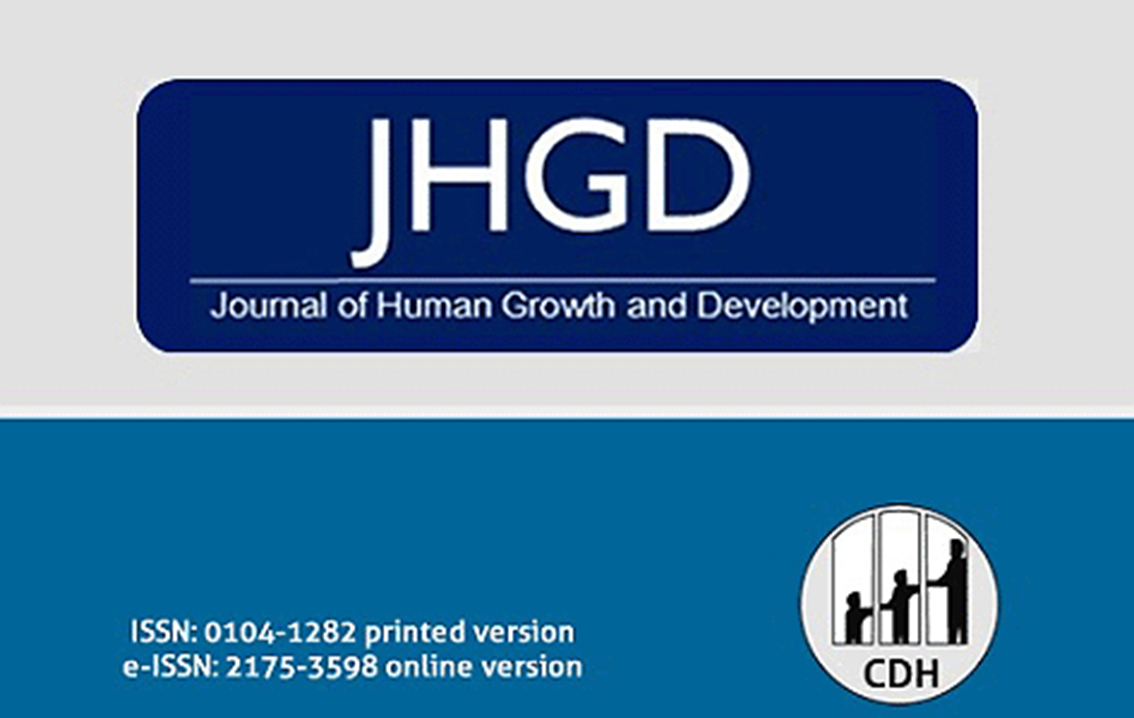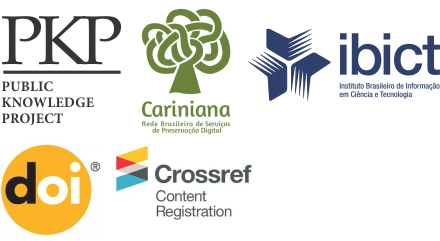Psychometric validation of the Brazilian Portuguese version of the Body Image Scale – HIV for people living with HIV/AIDS
DOI:
https://doi.org/10.36311/jhgd.v32.13326Keywords:
Body Image, Appearance, HIV/AIDS, psychometricsAbstract
Introduction: Body Image can be defined as the mental representation of body identity. The surroundings, the gaze of the other, they emotions, they integrity, and our own fragility are elements of this representation. The social stigma caused by body changes in people living with HIV / AIDS may be more intense than the fear of death itself, being important to assess the impact of these changes in the course of treatment.
Objective: To perform the psychometric validation of the Brazilian Portuguese version of the Body Image Scale - HIV for a sample of Brazilians, of both sexes, living with HIV / AIDS.
Methods: The total of 1050 patients were recruited from the São Bernardo do Campo HIV/AIDS program, aged between 18 and 78 years. Confirmatory factor analysis using the Unweighted Least Square and listwise deletion was used to determine the adherence of the data to the models tested.
Results: Adequate coefficients of internal reliability and evidence of construct validity were established for the Brazilian version of BIS-HIV in the unifactorial model.
Conclusion:This scale, with evidenced psychometric qualities, provides a useful tool for quantitative investigations of body image in people with HIV/AIDS in the Brazilian context and extends the possibility of future cross-cultural research.
Downloads
References
Abel, G., & Thompson, L. (2018).“I don’t want to look like an AIDS victim”: A New Zealand case study of facial lipoatrophy. Health & social care in the community, 26(1), 41-47.
Alexias, G., Savvakis, M., &Stratopoulou, Ι. (2016).Embodiment and biographical disruption in people living with HIV/AIDS (PLWHA). AIDS care, 28(5), 585-590.
Apodaca, M. J., Molero, F., Sansinenea, E., Holgado, F. P., Magallares, A., &Agirrezabal, A. (2018). Discriminación percibida, autoexclusión y bienestar entre las personas con VIH en función de los síntomas de la lipodistrofia. Anales de Psicología, 34(1), 7-15.
Ballester-Arnal, R., Gómez-Martínez, S., Fumaz, C. R., González-García, M., Remor, E.,&Fuster, M. J. (2016). A Spanish study on psychological predictors of quality of life in people with HIV. AIDS and Behavior, 20(2), 281-291.
Beaton, D. E., Bombardier, C., Guillemin, F., &Ferraz, M. B. (2002) Recommendations for the cross-cultural adaptation of healthy status measures. Chicago, IL: American Academy of Orthopedic Surgeons/Institute for Work & Health
BRASIL. Ministério da Saúde. Secretaria de Vigilância em Saúde. Departamento de DST, Aids e Hepatites Virais. Manual de tratamento da lipoatrofia facial: recomendações para o preenchimento facial com polimetilmetacrilato em portadores de HIV/AIDS. Brasília: Ministério da Saúde, 2009. [acesso em: 2019 mar 28]. Disponível em: http://www.saudedireta.com.br/docsupload/1340370403man_lipoatrofia03-web.pdf
Brener, L., Callander, D., Slavin, S., & de Wit, J. (2013). Experiences of HIV stigma: the role of visible symptoms, HIV centrality and community attachment for people living with HIV. AIDS care, 25(9), 1166-1173.
Brown, T. A. (2015). Confirmatory factor analysis for applied research. New York: The Guilford Press
Cash, T.F. (2000) The Body Image workbook: an 8-step program for learning to like your looks. New York: The Guilford Press.
Cash, T (2012).Cognitive-behavioral perspectives on body image. In: T. Cash (ed). Encyclopedia of body image and human appearance. (p. 334-342). Londres: Elsevier.
Cash, T. F.; Smolak, L. (2011) Body image: A handbook of science, practice, and prevention. Nova Yorke: Guilford Press
Campana, A. N. N. B., & Tavares, M. D. C. G. C. (2009).Avaliação da imagem corporal: instrumentos e diretrizes para a pesquisa. São Paulo: Phorte.
Cofrancesco, J. J., Brown, T., & Martins, C. R. (2004).Management options for facial lipoatrophy. The AIDS reader, 14(12), 639-40.
Engler, K., Lessard, D., &Lebouché, B. (2017).A review of HIV-specific patient-reported outcome measures. The Patient-Patient-CenteredOutcomesResearch, 10(2), 187-202.
Farinatti, P., Andrade, B., Paes, L., & Borges, J. (2013).Lipodystrophy and body image in physically active and sedentary HIV-infected patients. Archives of Exercise in Health and Disease, 4(1), 227-233.
Fernandes, A. P. M., Sanches, R. S., Mill, J., Lucy, D., Palha, P. F., &Dalri, M. C. B. (2007). Síndrome da lipodistrofia associada com a terapia anti-retroviral em portadores do HIV: considerações para os aspectos psicossociais. Revista Latino-americana de Enfermagem, 15(5), 1041-1045.
Franco, M.T.(2013). Lipodistrofia e percepção corporal em pessoas vivendo com HIV. [Trabalho de conclusão de curso]. Especialização em saúde pública, departamento de medicina social, faculdade de medicina, Universidade Federal do Rio grande do Sul, Porto Alegre.
Gagnon, M., & Holmes, D. (2016). Body–drug assemblages: theorizing the experience of side effects in the context of HIV treatment. Nursing Philosophy, 17(4), 250-261.
Garson, G. D. (2006). PA 765 Statnotes: an online Textbook. Retrieved March 13, 2011, from http://www2.chass.ncsu.edu/garson/pa765/statnote.html.
Geary, C., Parker, W., Rogers, S., Haney, E., Njihia, C., Haile, A., &Walakira, E. (2014). Gender differences in HIV disclosure, stigma, and perceptions of health. AIDS care, 26(11), 1419-1425.
Greco, D. B., &Simao, M. (2007). Brazilian policy of universal access to AIDS treatment: sustainability challenges and perspectives. Aids, 21, S37-S45.
Hair, Jr., J. F., Anderson, R. E., Tatham, R. L. & Black, W. B. (2009) Multivariate data analysis. Upper Saddle River, NJ: Prentice Hall.
Herdman, M., Fox-Rushby, J. &Badia, X. (1998). A model of equivalence in the cultural adaptation of HRQol instruments: The universal approach.Quality Of Life Research, 7, 323-335.
Hölzel, L., Härter, M., Reese, C., &Kriston, L. (2011).Risk factors for chronic depression—a systematic review. Journal of affective disorders, 129(1-3), 1-13.
Huang, J. S., Harrity, S., Lee, D., Becerra, K., Santos, R., & Mathews, W. (2006). Body image in women with HIV: a cross-sectional evaluation. AIDS research and therapy, 3(1), 17.
Imbroll, M. G., Fenech, M., &Gruppetta, M. (2017).Lipodystrophy: focus on HIV Lipodystrophy. Malta Medical School Gazette, 1(2), 48-52.
Joint United Nations Programme on HIV/AIDS (UNAIDS) (2014). The gap report. Geneva: UNAIDS.
Joint United Nations Programme on HIV/AIDS (UNAIDS) (2017). Universal access to top-of-the-line medication in Brazil Disponívelem: http://www.unaids.org/en/resources/presscentre/featurestories/2017/july/20170714_brazilAcessadoem 10/01/2019
Jöreskog, K. &Sörbom, D. (1999).PrelisTM2: User’s reference guide. Chicago, IL: Scientific Software International
Lupton, D. (2012). Medicine as culture: Illness, disease and the body. Los Angeles: Sage
Luz, P. M., Girouard, M. P., Grinsztejn, B., Freedberg, K. A., Veloso, V. G., Losina, E., ... &Walensky, R. P. (2016). Survival benefits of antiretroviral therapy in Brazil: a model‐based analysis. Journal of the International AIDS Society, 19(1), 20623
Kaplan, D. (2000) Structural equation modeling: foundations and extensions. Sage Publications, Thousand Oaks, CA
Mancini, T., &Secchiaroli, G. (2015). Threats to identity: lipodystrophy and identity changes in people with HIV/AIDS (PWA). Acta Bio Medica AteneiParmensis, 86(1Suppl), 29-39.
Marôco, J (2014) Análise de equações estruturais.[Analisysofstructuralequations] 2ª ed. Report Number: PêroPinheiro
Martinez, S. M., Kemper, C. A., Diamond, C., Wagner, G., & California Collaborative Treatment Group. (2005). Body image in patients with HIV/AIDS: assessment of a new psychometric measure and its medical correlates. AIDS Patient Care & STDs, 19(3), 150-156.
Milam, J. E. (2004). Posttraumatic growth among HIV/AIDS patients 1. Journal of Applied Social Psychology, 34(11), 2353-2376.
Ministério da Saúde (2014) ‘Global AIDS Response Progress Reporting Narrative
Report – Brazil. Disponível em: http://www.unaids.org/sites/default/files/country/documents/BRA_narrative_report_2014.pdf Acessado em 10/01/2019
Njelekela, M., Mpembeni, R., Muhihi, A., Ulenga, N., Aris, E.,&Kakoko, D. (2017). Lipodystrophy among HIV-Infected Patients Attending Care and Treatment Clinics in Dar es Salaam. AIDS research and treatment, 2017.
Nunnaly, J. (1978). Psychometric theory. New York: McGraw-Hill.
Peterson, S., Martins, C. R., &CofrancescoJr, J. (2008).Lipodystrophy in the patient with HIV: social, psychological, and treatment considerations. Aesthetic Surgery Journal, 28(4), 443-451.
Phillips, K. D. (2011). Conceptual development of an instrument to measure the internalized stigma of AIDS based on the Roy adaptation model. Nursing science quarterly, 24(4), 306-310.
Reynolds, N. R., Neidig, J. L., Wu, A. W., Gifford, A. L., & Holmes, W. C. (2006). Balancing disfigurement and fear of disease progression: Patient perceptions of HIV body fat redistribution. Aids Care, 18(7), 663-673.
Rzeszutek, M &Gruszczyńska, E. (2018) Posttraumatic growth among people living with HIV: A systematic review. Journal of psychosomatic research, 114, 81-91.
Sabin, L. L., Desilva, M. B., Hamer, D. H., Keyi, X., Yue, Y., Wen, F., ...& Gill, C. J. (2008). Barriers to adherence to antiretroviral medications among patients living with HIV in southern China: a qualitative study. AIDS care, 20(10), 1242-1250.
Sanches, R. S., Mill, J., Machado, A. A., Donadi, E. A., & Fernandes, A. P. M. (2009). Facial lipoatrophy: appearances are not deceiving. Journal of the Association of Nurses in AIDS Care, 20(3), 169-175.
Schilder, P. (1980).A Imagem do Corpo: as energias construtivas da Psiquê. São Paulo: Martins Fontes
Schumacker, R. E. & Lomax, R. G. (2004).A begginer’s guide to structural equation modeling.UpperSaddle River, NJ: Lawrence Erlbaum Associates.
Seidl, E. M., & Machado, A. C. (2008). Bem-estar psicológico, enfrentamento e lipodistrofia em pessoas vivendo com HIV/AIDS. PsicologiaemEstudo, 13(2).
Shilling, C. (2012).The body and social theory. Nottingham: Theory, Culture and Society.
Silvia, E. S. M. &Maccallum, R. C. (1988). Some factors affecting the success of specification searches in covariance structure modeling. Mutlivariate Behavioral Research, 23, 297-326.
Simbayi, L. C., Kalichman, S., Strebel, A., Cloete, A., Henda, N., &Mqeketo, A. (2007). Internalized stigma, discrimination, and depression among men and women living with HIV/AIDS in Cape Town, South Africa. Social science& medicine, 64(9), 1823-1831.
Tavares, M.C.G.C.F. (2003). Imagem corporal: conceito e desenvolvimento. Bareuri: Manole.
Tate, H., & George, R. (2001).The effect of weight loss on body image in HIV-positive gay men. AIDS care, 13(2), 163-169.
Van de Vijver, F. J., &Poortinga, Y. H. (2004). Conceptual and methodological issues in adapting tests. In Adapting educational and psychological tests for cross-cultural assessment (pp. 51-76). Psychology Press.
Vance, D. E., Moneyham, L., Fordham, P., &Struzick, T. C. (2008). A model of suicidal ideation in adults aging with HIV. Journal of the Association of Nurses in AIDS Care, 19(5), 375-384.
Wallace, M. L. (2012). Body Image Issues among Individuals with HIV and AIDS. I.: T. Cash & L. Smolk (Eds). Encyclopedia of Body Image and Human Appearance (pp. 250-256). Nova Yporke: Guilford Press
Webel, A. R., Longenecker, C. T., Gripshover, B., Hanson, J. E., Schmotzer, B. J., &Salata, R. A. (2014). Age, stress, and isolation in older adults living with HIV. AIDS care, 26(5), 523-531.
Wet, K., &Wouters, E. (2016). Identity and the body: Narrative accounts of two HIV-positive women with lipodystrophy in post-apartheid South Africa. Social Theory & Health, 14(3), 351-371.
Yang, H. J., Lee, H. K., & Kim, M. (2015).The concept analysis of body image of people living with HIV/AIDS. InternationalJournalofBio-ScienceandBio-Technology, 7(4), 315-334.
Downloads
Published
Issue
Section
License
Copyright (c) 2022 Martins WH, Martins MA, Pereira Filho GV, Pessoa KVO, Neves AN, Abreu LC

This work is licensed under a Creative Commons Attribution 4.0 International License.







